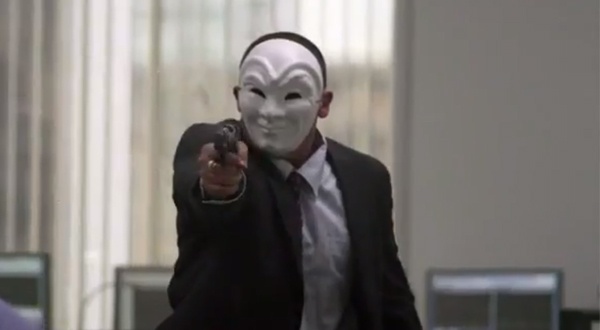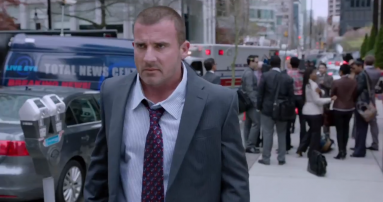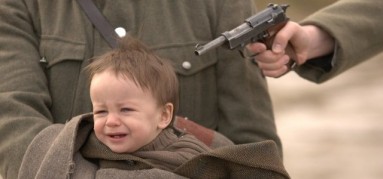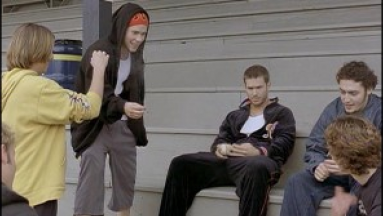It's director Uwe Boll's incompetence that permits his films to make a radical critique of contemporary violence
If someone had told me in 2010 that the most conspicuous U.S. social movement in 40 years would be sparked by Adbusters magazine, I would have laughed in their face. If someone had told me in 2012 that the most politicized narrative film about the financial crisis would emerge from the camera of Uwe Boll — the director famous for terrible movies based on video games, including Blood Rayne, Alone in the Dark, and Postal — I would have told them to stop trolling. But here we are in 2013, with Occupy Wall Street in the rearview and Uwe Boll’s Assault on Wall Street looking for wide-release distribution.
Despite the title’s promise of violence, much of Assault on Wall Street’s running time involves watching a white middle-class couple’s lives get destroyed by the financial crisis. Jim Baxford (Dominic Purcell) is a New Yorker with a stable job as an armored-car security guard. His wife (Erin Kapluk) is out of work, undergoing treatment for a brain tumor. As happens to many Americans dealing with chronic illness, his health insurance “caps out,” meaning he has to pay for her treatment out of pocket. No problem, though: He’s got a big nest egg invested with a Wall Street brokerage firm.
Except, as we see in the first scene, that brokerage firm was perpetrating a real estate scam. Jim discovers his nest egg isn’t only gone, but he owes the banks $60,000. From there, things fall apart for Jim with inexorable efficiency: scene after scene of Jim in a series of indistinguishable offices, receiving devastating news with apologetic finality. The bank refuses to refinance his home, so he starts putting his wife’s treatments and pharmaceuticals on a credit card. He spends the last of his cash on a shady lawyer who promises to get his money back — and then promptly fails. Debt collectors start hounding him, so he loses his job; you can’t protect an armored car full of money if you’re in deep debt. The house is foreclosed. His wife kills herself.
So what does Jim do? He moves into a ratty pay-by-the-week hotel and begins pinning articles from Financial Times-esque papers on the wall, “unveiling” a conspiracy in true cinematic-paranoid fashion. He connects articles to photos of bankers with red yarn — and then starts murdering them. At first he assassinates particular high-level bankers, but the film’s climax sees him go to Wall Street with an assault rifle, a couple of handguns and grenades, and a weird amorphous white mask (one suspects Boll wouldn’t pay for the rights to a Guy Fawkes mask) to engage in a mass shooting. After picking off the broker who screwed him personally, he shoots wantonly at bankers and anyone in suits. He then goes up into the brokerage firm and kills almost everyone in the office.
This is not the most shocking thing about Assault on Wall Street. What’s shocking is not that it directly proposes political violence against the banks but that it is the first film to do so. Perhaps most shocking of all is that such violence has not yet actually occurred.
•••
Despite the intense media interest in mass shootings and their ability to produce “serious” political discussion about mental health or gun control, there are almost no American narrative films about mass shootings. The only three I could think of — Elephant, We Need to Talk About Kevin, and Home Room — are about school shootings, and only Elephant actually depicts the violence. While there are serial killer movies, action movies with huge bystander body counts, and disaster films in which whole cities are obliterated, there are few 21st century films about the increasingly common form of public random mass violence by and against adults. Except, that is, by Uwe Boll.
It takes only four sentences for Boll’s Wikipedia entry to reveal that he “has been described as ‘the Ed Wood of the 21st century.’” The comparison is apt in some ways. Like Wood, Boll usually produces and/or writes the films he directs, often displaying a total technical ineptitude that fails to even approximate the cinematic standards they aspire to. Like Wood, Boll has a preference for genre film, particularly horror. And like Wood, Boll’s most famous failures (House of the Dead, Alone in the Dark) are by no means his most interesting work.
But there the comparisons end. Wood completed only 12 features in his 15-year career before hanging up his beret and turning to writing true-crime and pornographic novels; Boll has made 23 films in the past decade alone and shows little sign of slowing down. Wood worked in total obscurity, while Boll’s video-game films have received major distribution (Alone in the Dark opened in more than 2000 theaters). Wood never learned how to make movies well, but Boll has progressed beyond complete incompetence. And most important, Wood never engaged political questions (except murkily in Glen or Glenda, a film about cross-dressing), whereas Uwe Boll’s films do this, and often.
Apart from Assault on Wall Street, Boll’s most directly “political” films are Auschwitz, Darfur, and Tunnel Rats 1968. Auschwitz, a 2011 film which opens with documentary interviews of German teens unable to produce accurate information about Hitler or the Holocaust, portrays in cold, emotionless detail the Arendtian banality and bureaucratic tedium that support the total violence of the concentration camp. It’s a cruel and horrific film, ultimately undercut by its aping of horror affect and aesthetic. (Particularly awful are some fast-cutting shaky cam scenes inside the gas chambers.) Darfur (2009), about American journalists investigating the genocide, is as white-saviory as that clause-length synopsis would suggest, and Tunnel Rats 1968 (2008) is a boilerplate war-is-hell-but-also-all-this-film’s-pleasures-emerge-from-watching-war Vietnam movie.
But these are not Boll’s most interesting works. He is the only filmmaker interested in investigating the likelihood of a violent response to political powerlessness — mass shootings. He has made three films explicitly about such shootings: Assault on Wall Street, Heart of America, and Rampage, and such incidents feature heavily in a fourth, the execrable Postal. Unlike news-media reports, these films refuse to contextualize shootings exclusively through the psychological disturbance of the killers. Boll’s films instead attempt to understand these acts as a response to structural violence — to the systemic, often invisible forms of oppression that are not recognized as violence as such because of their dispersed societal deployment.
If shootings were merely a matter of mental illness combined with lax gun control, then there would be almost as many shootings in Canada, where, as Michael Moore's Bowling for Columbine — by far the most financially successful film about school shootings — points out, gun ownership and ease of acquisition is similar. Yet despite the near predictable regularity of mass shootings in America, the media narrative typically zeroes in on the shooter’s individual madness.
Coverage of the Columbine shooting focused on the media-consumption habits of the teenage shooters, Kleibold and Harris — the fact that they played Doom, listened to Marilyn Manson, and wore trench coats was thought to be paramount. Sandy Hook’s aftermath included debate in the media about gun control and mental health, though shooter Adam Lanza did not have any mental-health issues that predisposed him to violence (he may have had Asperger syndrome), not to mention the fact that mental illness is much more likely to make someone a victim of violence than a perpetrator. Gun-control laws might well have kept him from having the high magazine assault rifle that made his rampage so deadly, but there’s no reason to believe he wouldn’t have done it if he had access only to handguns.
The main distinction between media coverage of Tucson shooter Jared Lee Loughner, a diagnosed paranoid-schizophrenic, and of James Egan Holmes, the apparently well-adjusted, straight-A neuroscience Ph.D. candidate who shot up the Dark Knight screening in Aurora, Colorado, is that commentators openly call Loughner crazy while insinuating Holmes’s insanity. (Isn’t it suspicious that he suddenly dropped out of his Ph.D. program? Interesting, isn’t it, how much he used adult websites and, perhaps, hired prostitutes?) When you look up either Loughner and Holmes, the second suggested Google search following their name is “mental illness.”
Uwe Boll’s mass shootings, by contrast, feature desperate killers whose emotional disturbance just plays one part in their indiscriminate violence. In Assault on Wall Street, We see Jim slip into paranoia and isolation but only after his life has been stolen from him by economic forces. Similarly, the bullied teenage murderers of Heart of America (2002) are alienated and depressed, but the film spends much more time dissecting the nature of their bullies than the content of their depression.
Heart of America takes place entirely on the morning leading up to a school shooting, with some interspersed flashbacks. It’s the last day of the school year, and we watch a number of students and administrators getting ready for the day. The film, like all school-shooting movies, displays the broken home life and extreme bullying that the school shooters face. But it also shows a number of stories that are not proximate causes of the shooting. A football player, sitting in his car in the school parking lot with his virginal girlfriend, dumps her for refusing to sleep with him, after revealing that he is not a virgin and that he has been cheating on her with a number of girls. The creative-writing teacher, frustrated at his inability to write a novel, is confronted by the principal for humiliating students, giving them unfairly low grades and publicly shaming them.
These stories, which mostly do not directly affect the shooters, establish the context in which the school shooting occurs — an atmosphere of patriarchal violence and sexual cruelty, particularly that of teen boys. The film’s opening epigraph points out that “83 percent of the school victims, and 96 percent of the offenders, were male.” The most notable of these framing stories, one which takes up a significant amount of screen time, involves an already graduated older brother telling his younger brother’s gang of bullies about “the craziest thing he ever did” as they all smoke weed on a baseball field. Frank, the elder brother, describes with pride how he and his friends brought home and raped a mentally challenged girl. Ricky, the younger brother, watches him with increasing hatred and disgust, while the rest of the boys laugh and cheer.
Ricky asks Frank if their dad knew about this, and Frank says, “He said it was something he and his friends might’ve done.” Ricky realizes that he and his friends have also sexually humiliated their victims. Though the psychological and sexual torment of the killers contributes to their actions, by showing how that torment is produced by a patriarchal (even patrilineal) series of rapist-bullies, the film looks beyond the individual psyche of the killers, even beyond the problem of “bullying,” toward larger structures of oppression and violence as the cause of school shootings.
Rampage (2009), a genuinely well-made and entertaining movie, is about Bill Williamson, a young white man living with his parents in a small town. He has a low-wage job as a mechanic (his boss refuses flatly when he asks for a raise), and his parents want him out of the house. His only friend, Evan, makes pseudo-leftist populist-rant videos and posts them on YouTube. The first half of the film comprises scenes of Bill working out, eating, or hanging out alone while a radio, TV, or Internet video blares stories of economic, ecological, and political crisis. (Boll relies on this same contextualizing technique in Assault on Wall Street.) The second half of the film involves Bill, wearing a bulletproof suit of armor he’s welded at his job, shooting dozens of people in his town. His first act is to blow up the police station with a remote-control van to make sure he goes unopposed. At the end of his rampage, he meets Evan for a “game of paintball” he’s arranged, shoots him with a stun gun, dresses him in his rampage armor, and stages Evan’s murder like a suicide, framing him for the crimes.
Back at home, as Bill packs his bags (he’s robbed a bank and intends to leave town with the money) another TV news story reveals Evan’s father, who has been arrested, was a “radical and extreme protester in the ’60s and ’70s … and has always been strongly outspoken against the government … It appears that radical measures to get your opinions out runs in the family.” The film ends with a video Bill has made himself, in which he says “there’s no chance that we can survive … 70 million people every year are brought into this earth … sucking up our resources. There’s too many people, so what do we do? Just keep them around? Let’s kill them!”
Once again, the shooter reaches toward structural causes for his violence and once again, his actions in response to this structure are insufficient, perhaps even evil, but more than just insane. We see Bill struggling, as Jim in Assault on Wall Street does with his red yarn and finance articles, to understand the totality that denies him the life he wants, thinking, as the shooters claim in Heart of America, that this violence is the only way he can make a mark on the world.
These fringe Boll films are among the few willing to venture what ought to be darkly obvious questions: Is the mass shooter an inevitable outcome of the total political powerlessness and hopelessness of American life at the end of history? Is the hysteria of the media’s reaction, and its attempts to depoliticize even the most political mass shootings —like those of LAPD enemy No. 1 Christopher Dorner — an effort to block these moments from becoming intelligibly symptomatic? Is our horror at each incident not because of some objective humanist reaction to violence — a reaction that inner-city murders and war massacres rarely seem to elicit — but rather our recognition that it is something culturally produced, socially appropriate, indeed, something we have seen the potential and desire for in our ourselves?
***
In an interview with, of all things, the Orange County Weekly, Boll explained his intentions with Assault on Wall Street: “I want [Wall Street executives] to get scared. In a way, they deserve to be miserable. In the film, the [killer] gets away in the end and says, ‘I'll keep doing it.’ So this is my message to them: Don't think you're safe.” If there could be a more direct evocation of weaponized cinema, I’m not sure what it would look like.
Does Boll’s status as the “worst filmmaker alive” allow him to get away with such movies? The fact that he’s a “bad filmmaker” — and he undoubtedly is — leads to the automatic rejection of his films in toto, just as a mass shooter’s being crazy — which indeed they are — is used to deny any critical content to their actions. Aesthetic judgment forestalls thought here in two ways: It shuts down our ability to take seriously a “bad” film, and, if we are to take it seriously, asks us to make a rehabilitative argument for the film aesthetically (at the very minimum, asking us to argue "it’s so bad it’s good”) as a precondition for the film’s discussion. Its "cultural importance" becomes a matter of the irony it induces, not the questions it confronts, no matter how clumsily.
It’s clear that Assault on Wall Street could never be made in Hollywood, although moments of the desires it plays out appear in mainstream cinema — for example in the takeover of the stock-market floor by the villains of The Dark Knight Rises. One of the major ideological functions of Hollywood is to obscure the role of structural violence in society or reframe that structural violence as necessary and just. But to sell tickets Hollywood must also play successfully enough to Americans’ desires. Of course, Hollywood, television, and advertising do what they can to shape those desires, but they haven’t totally succeeded and remain fundamentally reactive.
This is not to argue for Boll’s nomination into the cinematic canon or anything of the sort. But it’s almost absurdly neat that the man dubbed “the worst director alive” is the only director taking the events the media treats as the country’s worst tragedies seriously. From the victimized killers of Heart of America to the nihilist antihero of Rampage to the populist superhero of Assault on Wall Street, he offers a broad portrait of the possible causes and outcomes of alienated, individualized responses to structural violence. Unless halted by a unified and totalizing communal response to oppression and violence, the shootings will continue. And as long as Hollywood holds sway and American indie cinema shies away from such stories, it will devolve to Boll to tell the honest story of mass violence in America.




